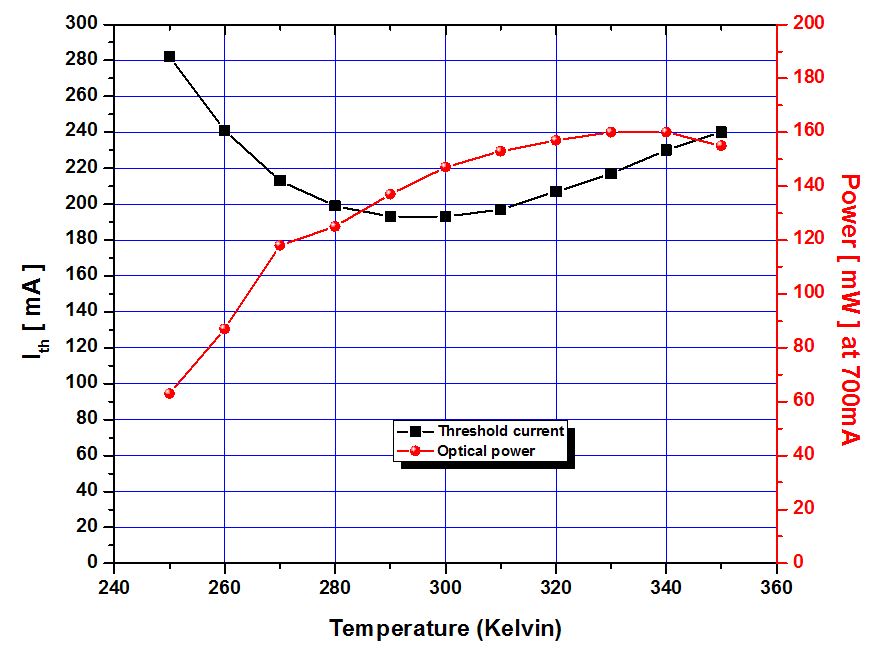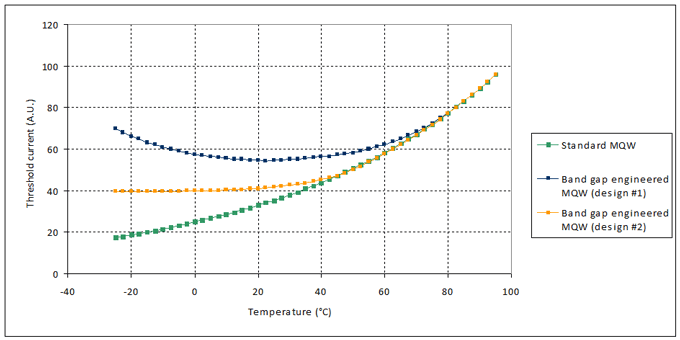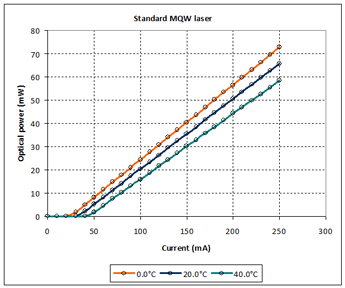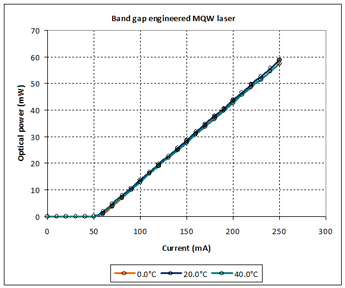
Summary
Researchers from
the University of
Surrey have developed a
novel design of multi-quantum well (MQW) laser that possesses a reduced thermal
sensitivity over a wide temperature range. Bandgap engineering alone is used to
improve the thermal stability of threshold current and slope efficiency compared
to traditional techniques. The patent-pending approach is fully compatible with
standard MQW materials and growth methods, and hence is readily adoptable by
existing MQW fabricators.
Background
The lasing
characteristics of MQW lasers, especially the threshold current and therefore
the output power at a given current, are very sensitive to temperature
variations. Because of this temperature sensitivity, thermoelectric coolers
(TECs) are required in order to maintain and control the ambient temperature of
these lasers when used in applications such as optical communications system and
medical instruments. However, TECs are an added cost in the packaging of these
devices and their reliability is also of some concern. Therefore, it is
desirable to design lasers that are less sensitive to temperature variations,
and which are capable of lasing at elevated operating temperatures (>100°C)
without the need for cooling.
Applications
Uncooled 13xx-nm
datacom
The design can
be applied to almost any quaternary material system operating at any optical
wavelength. This includes both datacoms (13xx-nm) and long-distance carrier
(15xx-nm) networks. Elimination of the TEC may prove particularly attractive for
applications such as high-density 100-GbE switches, and remotely powered systems
such as GPON networks.
Uncooled 14xx-nm Raman
pumps
Conventional
14xx-nm Raman pumps require thermoelectric coolers to maintain stable operation
at elevated ambient temperatures. Simulations indicate the band gap engineered
designs can operate up to 350°K with minimal change to the threshold current and
thereby optical power. As illustrated below, the threshold current remains with
10 percent of its ambient temperature (300°K) value from 270°K to 330°K, and
within 20 percent from 260°K to 350°K.

Elimination of the thermoelectric
cooler reduces the pump module power consumption from c.7W to 1.7W for
comparable output optical power (mW) at 75°C.
|
Parameter |
Symbol |
Vendor 1 |
Vendor 2 |
Vendor 3 |
Uni
Surrey |
|
Optical
power |
mW |
150 |
>140 |
180 |
160 |
|
Operating current
(nominal) |
mA |
800 |
600 |
870 |
700 |
|
Operating voltage
(max) |
V |
2.5 |
2.5 |
2.4 |
2.5 |
|
TEC current
(max) |
A |
1.5 |
1.5 |
2.2 |
Uncooled |
|
TEC voltage
(max) |
V |
3.8 |
3.5 |
3.0 |
Uncooled |
|
Module power consumption at
Tc=75°C (max) |
W |
5.4 |
6.7 |
8.7 |
1.7 |
Availability
Available for
licence
IP
Status
Patent
Pending
Technical
Customised band
gap modifications dramatically alter the temperature characteristics of the MQW
laser. As illustrated below, the engineered structure exhibits a significantly
higher characteristic temperature and therefore a weaker temperature
sensitivity. At lower temperatures the device exhibits a seemingly anomalous
phenomenon where the threshold current increases at lowered temperatures. Via
related mechanisms the slope efficiency is also
stabilised.

The net effect
is a MQW laser whose optical output power is essentially temperature independent
over a wide temperature range.


The content of this summary comes from
elucidare.co.uk http://www.elucidare.co.uk/assignments/project_bandgap/abst_bandgap.php